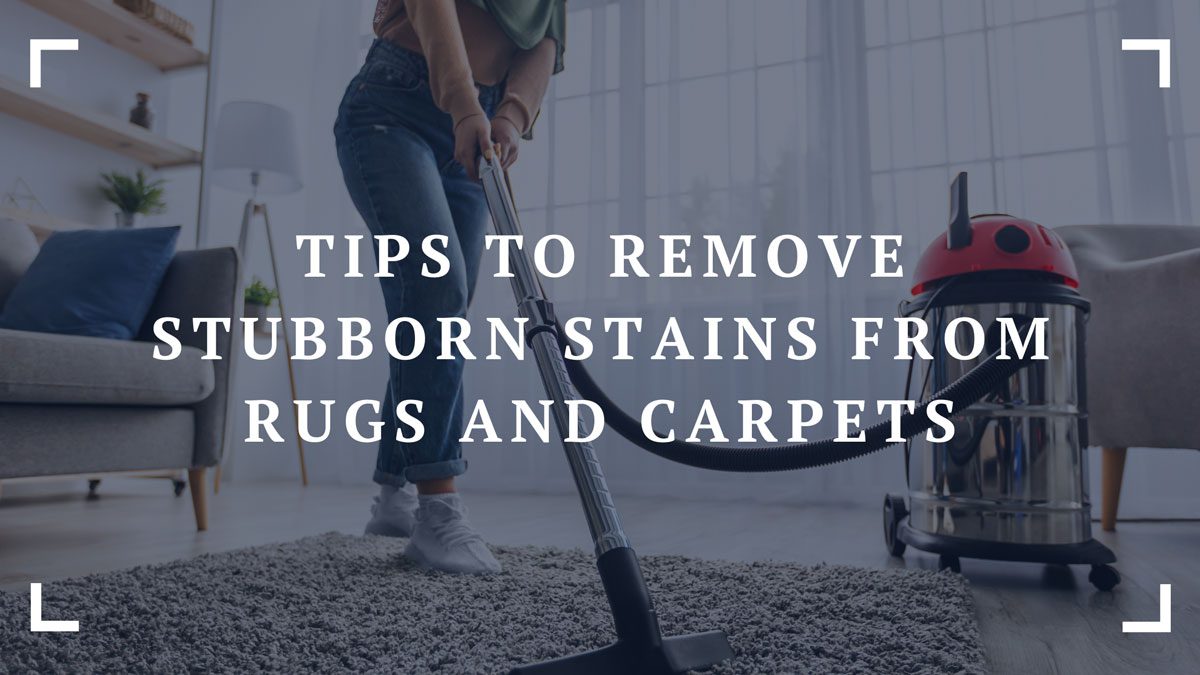Removing stubborn stains from rugs and carpets can often seem insurmountable, especially when dealing with materials that absorb spills quickly and where stains set in fast. Whether it’s a splash of wine, a drop of coffee, or the muddy footprints of a beloved pet, each stain presents its unique challenge. However, with the right techniques and patience, maintaining the pristine condition of your rugs and carpets is entirely achievable.
This comprehensive guide will walk you through essential tips for tackling even the most stubborn stains, ensuring your floor coverings remain as vibrant and welcoming as the day you bought them.

1. Identify The Stain
The first step in effective stain removal is accurately identifying the type of stain you’re dealing with. Different substances react uniquely to cleaning solutions; what works for one type of stain may set another permanently. Group stains into categories like protein-based (blood, food), tannin-based (wine, tea), oil-based (grease, lipstick), and dye-based (ink, marker) for targeted treatment.
2. Blot, Don’t Rub
The golden rule when a spill occurs is to blot, not rub. Rubbing a stain can work it deeper into the fibers, making removal more challenging. Always use a clean, dry cloth or paper towel to blot the affected area, absorbing the spill as much as possible before it sets.
However, for specialized care and professional advice on rugs and carpets like Megerian, consider consulting experts specializing in Megerian Rug and Carpet Cleaning, who can bring years of experience and expertise to the table, ensuring your textiles receive the best treatment possible.
3. Know When To Use Cold Or Warm Water
The water temperature used in stain removal is crucial to the treatment’s effectiveness. Cold water is particularly beneficial for protein-based stains, such as blood or dairy products, as it prevents the proteins from binding to the fibers, making the stain more difficult to remove.
On the other hand, warm water is more effective for melting or dissolving substances like chocolate, wax, or some types of makeup, thereby facilitating their removal from the carpet fibers. It’s essential to assess the nature of the stain before deciding on the water temperature to ensure the best approach for removal.
4. Consider Homemade Solutions
Resorting to simple, homemade solutions for stain removal can be surprisingly effective and is often more environmentally friendly and economical than commercial products. Dish soap mixed with water can cut through grease and oil-based stains due to the surfactant properties of dish soap, lifting the stain from the carpet fibers. White vinegar, diluted with water, can neutralize and lift stains from coffee, tea, and other acidic substances due to its mild acidity, which helps break down the stain.
Baking soda is another versatile household item known for its ability to absorb odors and moisture, making it particularly useful for wet stains or to freshen up the carpet area after a spill has been blotted away.
5. Use Hydrogen Peroxide
Hydrogen peroxide is a mild bleaching agent, making it particularly effective for removing stubborn stains such as wine, blood, or berry juices without the harsh effects of stronger bleaching. Its bubbling action helps lift the stain from the carpet fibers, making it easier to blot away.
However, its mild bleaching effect means it’s crucial to test it on a hidden area of the carpet first to ensure it won’t lead to discoloration. When used correctly, hydrogen peroxide can break down the stain components, rendering them colorless and significantly less visible.
6. Utilize Specialty Products And Techniques
When dealing with tough stains that resist general cleaning methods, turning to specialty products and techniques can be the key to success. The market offers a range of targeted solutions formulated for specific types of stains, such as enzymatic cleaners for pet stains, which break down biological matter, or products specifically designed to tackle red wine spills.
These specialized products often contain ingredients tailored to react with the specific compounds in the stain, either breaking them down or encapsulating them for simpler removal. It’s important to follow the instructions carefully and test the product in a small, inconspicuous area to ensure compatibility with your carpet’s material and dye.
7. Do Steam Cleaning

Steam cleaning employs high-temperature steam to penetrate deep into carpet fibers, effectively breaking down and dislodging dirt, grime, and stains. This method cleans the surface and sanitize by killing bacteria and dust mites, making it an excellent choice for allergy sufferers.
While renting equipment for DIY steam cleaning is an option, enlisting professional services is advisable for tackling extensive or particularly stubborn stains, ensuring a thorough and efficient cleaning process without risking damage to your carpets.
8. Conduct Regular Maintenance
Maintaining the condition of carpets and rugs is crucial for their longevity and appearance. Regular vacuuming removes surface dirt and prevents it from embedding deeper into the fibers. Addressing spills immediately can prevent them from setting and becoming permanent stains.
Incorporating professional cleanings into your maintenance routine can rejuvenate your carpets, removing accumulated dirt and stubborn stains. Lastly, implementing preventive measures, such as a no-shoes policy, can significantly reduce the introduction of dirt and contaminants, keeping your carpets cleaner for longer.
9. Educate Household Members
Involving all household members in carpet care can significantly enhance the effectiveness of your cleaning routines. Hence, educate them about the importance of immediate action upon spillage and the correct methods for stain treatment to prevent permanent staining.
Also, encourage a collective effort in maintaining carpet cleanliness to foster a sense of responsibility and ensures a consistent approach to preserving the aesthetic and hygienic condition of your floor coverings, contributing to a cleaner and more inviting home environment.
Conclusion
By following these tips, you can tackle even the most stubborn stains on your rugs and carpets, preserving their beauty and extending their lifespan. Remember, patience and prompt action are key. When in doubt, or faced with particularly challenging or delicate textiles, don’t hesitate to seek professional assistance to ensure your floor coverings receive optimal care.


